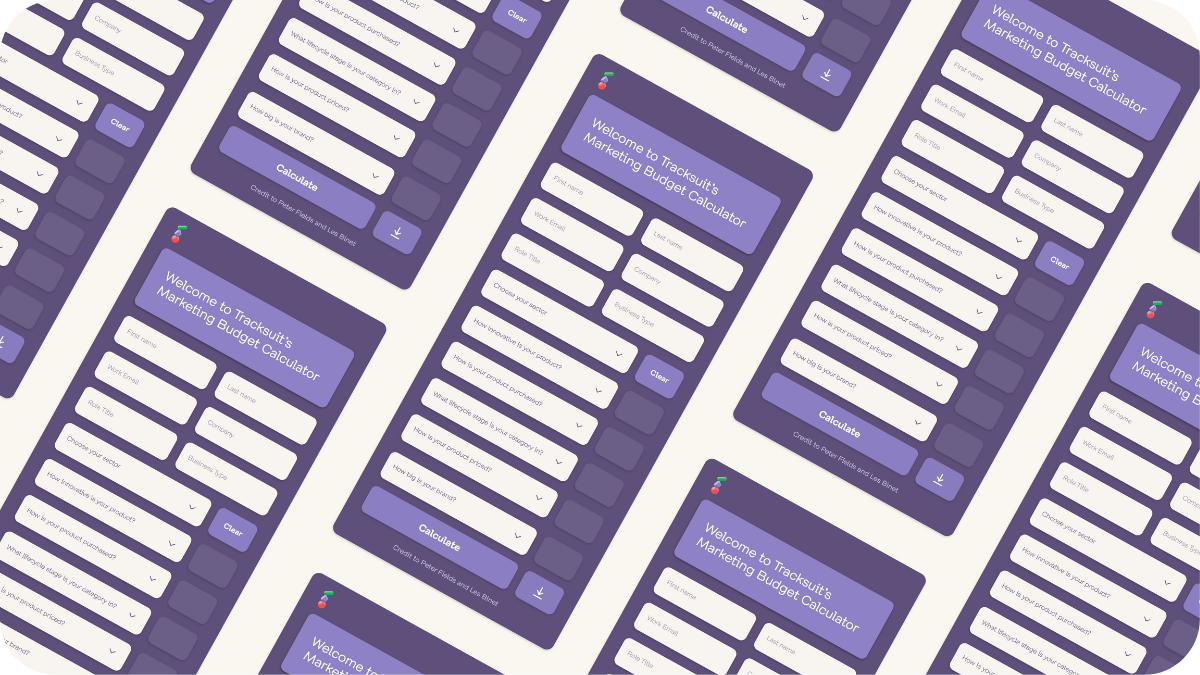Your Marketing Budget Calculator Results, Explained

If you’re reading this, you’ve likely seen Tracksuit’s Marketing Budget Calculator and have worked out the results of how your marketing budget should be split.
Want to look under the hood and learn why your brand marketing and sales activation budget split looks the way it does? 🚗
Let’s break down how your results are calculated!
What’s this data based on?
The formula the tool uses to calculate your results is based on the research of Les Binet and Peter Field, two globally renowned experts in marketing and advertising effectiveness.
They produced some hard-hitting research called Effectiveness in Context, opens in new tab, and it changed the game for marketers and advertisers.
They analyzed thousands of data points submitted to the IPA Databank alongside entries for the biennial Advertising Effectiveness Awards. This includes:
- A comprehensive range of campaign inputs (such as strategy, media choices and brand circumstances)
- Plus campaign outcomes (such as business-effectiveness measures, efficiency, return on marketing spend, and brand measures).
Any quotes you see in this blog are taken directly from Effectiveness in Context, opens in new tab
Sign up to Shorts
For fortnightly brand insights, stories and goodness that'll help you win (we promise).
60:40 — the brand marketer’s rule of thumb 👍🏽
Binet and Field came to a conclusion: the sweet spot for marketers is to spend around 60% of their budget on longer-term brand marketing campaigns and 40% on short-term sales activations.
But different contexts mean you need this rule to be able to flex on a case-by-case basis. So they overlayed some extra scenarios:
- What sector is your brand in?
- How do people purchase your brand?
- What’s your brand’s size?
- How innovative is your product?
- How mature is your brand’s category?
When to flex the 60:40 rule 📏
In general, you should be allocating more budget to brand-building when:
- Your context means brand building is more difficult
- Or when sales activation is easier.
How your industry affects your marketing split
Let’s start with your brand’s sector. Some purchase decisions are thought through, like buying a car. They are typically rational, researched decisions.
Other purchase decisions are made automatically, like grabbing some toilet paper at the supermarket. These are typically emotionally-led (I like this brand!) and less researched.
- For high-consideration purchases, sales activation is generally easier. “The more mental energy people put into the buying decision, the easier it is to elicit an immediate response from them.” If sales activation is easier, spend more on brand!
- For low-consideration purchases, brand building is generally easier. When a consumer isn’t thinking through a purchase, they’ll be more influenced by a positive brand. If brand building is easier, spend more on activation!
Different sectors have different levels of consideration, which changes the balance of brand to activation.
The Financial Services sector is the most extreme: Field and Binet conclude an 80:20 brand:activation split is optimal here 😱
Why? It’s likely to be because Financial Services choices are generally more rational and considered. This makes sales activation easier, and brand building much harder. So Financial Services brands need to radically shift their spending towards brand building.
Next up: How your brand is purchased
Online vs offline purchases 👩💻
- When consumers can purchase a product online, looking at reviews and exploring alternatives, most brands spend their marketing budget on short-term activation campaigns.
- The counterintuitive finding is that long-term brand building plays a bigger role in growth for online purchases. The world of online shopping is competitive, and brand building plays a bigger role than ever.
- When there are many options out there, consumers use brand as an indicator of quality to simplify how they decide what to buy.
- If your brand is purchased online, spend more on brand.
Subscriptions versus one-off transactions 🛍️
- Purchasing an online subscription tends to be a more considered, rational decision. Which makes it harder to build a brand.
- If your brand is purchased online via subscription, spend more on brand.
How is your brand innovating?
“The more radical your innovation is, the more important it is to support it with emotional brand building.”
That’s what Field and Binet found.
But it’s easy for marketers to assume that you don’t need brand building when your product (or category) is innovative. Maybe you can just tell people about the new product and they’ll come?
Not true. Innovation doesn’t last forever. So you need to spend more on brand to build a lasting presence.
The more innovation, the more your budget needs to be shifted towards brand.
How big is your brand?
Brand and activation is made easier or harder at different stages of a brand’s growth.
- New brands should gain market share as quickly as possible, especially while there is some buzz and attention. They should optimize for the short-term and spend more on activation.
- Small (but not as new) brands don’t have as much buzz, and brand building is harder. They should spend more on brand-building.
- Medium-sized brands fall somewhere in the middle.
- Big brands don’t need to spend such a high proportion of their budget on short-term activation. They can afford to focus more on the longer term and spend more on brand-building.
- Category-leading brands need to focus on maintaining their market share. And this is where spending more on brand helps keep them afloat.
What lifecycle is your category in?
Your overall category will also influence your spend on brand vs activation.
- New categories benefit from being innovative. We already know more innovation means more spending on brand, so the same is true here.
- Established categories with medium to high growth will find it easier to activate sales, so should spend more on brand (which is harder).
- In established categories that are declining or not growing much, more budget should be spent on activation. There is less value in brand building when the category isn’t performing well.
How is your product priced?
Finally, we come to pricing.
Expensive purchases tend to be highly considered. People tend to think more before they spend a lot!
- If you’re selling a premium holiday package, people will seek out information. They’ll visit that landing page. They’ll look at your package benefits.
- If it’s a well thought-out decision, your job is to be one of the first brands that person explores. “If people don’t put your brand on their consideration list, you won’t get a chance to wow them with your products and prices.”
- You can do this by spending on both brand and activation. A mix of the two is important.
- More premium brands should default to the standard brand to activation split.
Value or mainstream purchases are made at a lower price-point.
- When people are paying less, they tend to think less about the purchase.
- Which means they often default to whatever brand they have the strongest attachment to.
- Cheaper brands should spend more on brand-building.
- Why? If you’re purchasing something expensive, you tend to consider the decision more.
So where does that leave us?
Both short-term activation and long-term brand building are needed for business success.
When brand-building is harder or activation is easier, more of the budget should be spent on brand-building.
But we often see the opposite. When brand-building is hard, marketers often ignore it and focus on sales activation. At Tracksuit, we back businesses doubling down on brand.
We can finish off with a fully worked example. This example shows how different contexts can change how you allocate your budget.
This is taken directly from Effectiveness in Context, opens in new tab
You are launching a new non-food FMCG brand as a subscription-purchase pioneer in its category and it will be at the value end of a category: how should brand and activation be balanced?
The finishing line 🏁
We hope this article has helped you better understand the calculations behind your recommended brand activation budget split.
If you’ve got any lingering questions, be sure to reach out to our team and we’ll be happy to help out.
Happy brand building (and budgeting)!



